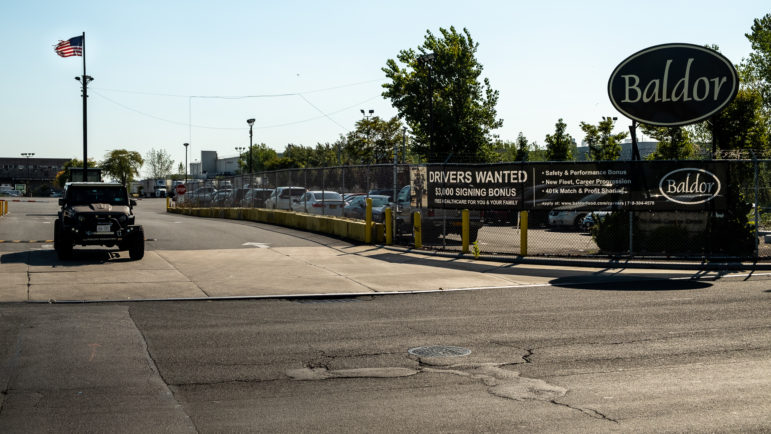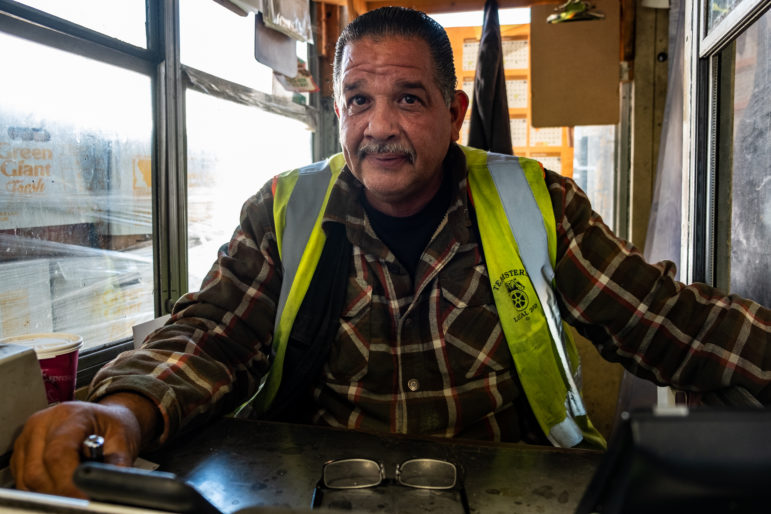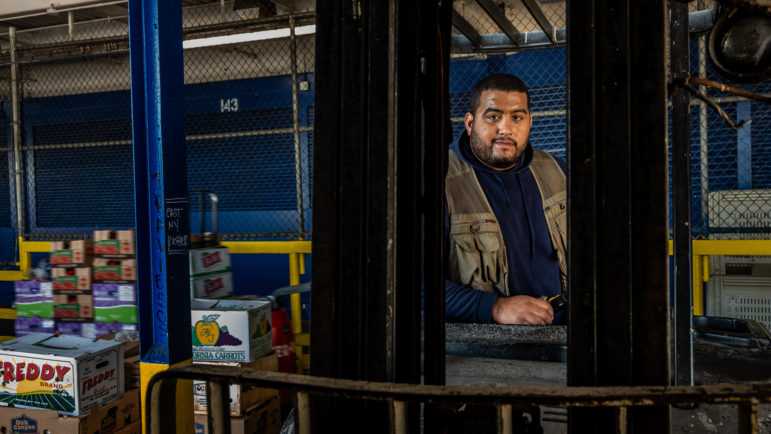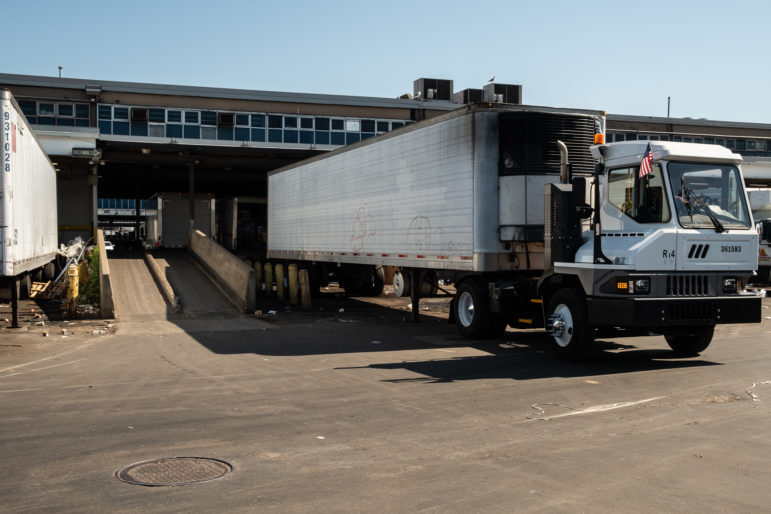Superstorm Sandy spared the Hunts Point Food Distribution Center, New York City’s most important food source. But a decade later, little has changed when it comes to storm resiliency at the low-lying markets, and a disaster could have a major impact for the city’s restaurants, shops and food pantries.
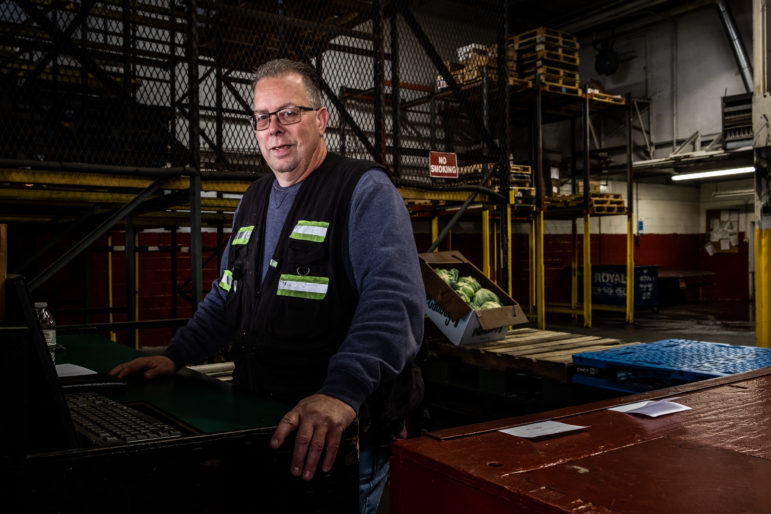
Adi Talwar
“We got lucky,” said Joey DeRosa, a warehouse manager at M & R Tomato Distributors, who has worked in the controlled chaos of the Hunts Point Terminal Produce Market for 34 years. “Next time we might not be so lucky.”City Limits’ is examining the impact and legacy of Hurricane Sandy as we approach the 10th anniversary of the storm this week. Help us report on this issue by sharing your Sandy story with us here.
Each day, an army of laborers at the Hunts Point Food Distribution Center load tons of tuna, t-bones and tomatoes on and off 13,000 trucks destined for 42,000 restaurants, bodegas and supermarkets across New York City. A network of warehouses and refrigerated trailers store billions of pounds of produce and protein at the country’s largest centralized food hub over the course of the year.
All told, about 25 percent of the produce, 35 percent of the meat and 45 percent of the fish consumed in the five boroughs comes through the Hunts Point markets, according to the New York City Economic Development Corporation (NYCEDC), which owns the land. Other estimates put those amounts even higher. The city’s 2013 Special Initiative for Resiliency and Rebuilding (SIRR) report, published in the wake of Hurricane Sandy, said 60 percent of the city’s produce passes through Hunts Point.
That study, followed by a series of ensuing reports, highlighted the low-lying food hub’s vulnerability to storm surge in the event of a major hurricane, and the impact that a prolonged disruption could have on the region. The Food Distribution Center narrowly avoided that fate in 2012, when Hurricane Sandy struck at low tide and spared the peninsula—and its 100-plus food wholesalers—from the flooding that devastated Lower Manhattan, Red Hook and the Rockaways.
“We got lucky,” said Joey DeRosa, a warehouse manager at M & R Tomato Distributors, who has worked in the controlled chaos of the Hunts Point Terminal Produce Market for 34 years. “Next time we might not be so lucky.”
But a decade later, little has changed when it comes to storm resiliency at the markets.
The city scrapped ambitious but expensive strategies for a flood wall to protect the Food Distribution Center, surrounded on three sides by the Bronx and East Rivers. More modest plans aimed at ensuring back-up power in case of an outage—a key concern for business owners and employees—have dragged on, with some still years from completion.
NYCEDC introduced long-awaited backup generators to the meat market, but canceled a plan to build a microgrid because the project would have violated local emissions laws. A smaller-scale replacement is still three years from completion. Meanwhile, NYCEDC was only just awarded $15 million in federal grant money to “harden” some of the market’s most vulnerable buildings by plugging holes and protecting electrical equipment.
The slow pace of progress leaves the businesses, and a good chunk of New York City’s food network, susceptible to another Sandy-like storm, say local organizers, food policy experts and Hunts Point workers themselves.
Dr. Charles Platkin, the executive director of Hunter College’s New York City Food Policy Center, said the city has wasted a decade when it could have pursued stronger protections for the vital markets.
“There needs to be transparency, there need to be facilities protected from storm surges and there need to be new facilities that are energy efficient,” said Platkin, who studies the Food Distribution Center and the city’s food network.
A food hub at risk
No one denies the potential impact of a storm surge at the tip of the Hunts Point peninsula. Con Edison elevated a power station just outside the markets to prevent flood damage a few years before Sandy. At a wastewater treatment plant next to the fish market, the Department of Environmental Protection (DEP) is in the process of building flood protection walls, installing water-proof doors and raising pieces of mechanical equipment.
Back in 2012, Sandy sent water surging over the bank of the East River and into the graded parking lot of New Fulton Fish Market, where it stopped and receded. That close call was a reminder about the risk of future flooding.
“When it comes to Hurricane Sandy, we really lucked out at Hunts Point,” NYCEDC Vice President Julie Stein told an audience at a panel discussion hosted by the Food Policy Center in 2016. “If the storm had hit several hours earlier or later, we would have been in a really different situation.”
Nearly a third of the Food Distribution Center land is located in the current 100-year floodplain, an area with at least a 1 percent chance of flooding each year, according to Federal Emergency Management Agency (FEMA) maps. Future floodplain projections encompass nearly the entire food hub, which includes the airplane hangar-like fish market, the congested Hunts Point Terminal Produce Market and the massive Hunts Points Cooperative Market, which deals with meat. Six large corporations—Krasdale, Baldor, Anheuser Busch, Chef’s Warehouse, Citarella and Sultana—lease stand-alone facilities in the Food Distribution Center, with all but Baldor situated along the waterfront.
All told, New York City’s most important food center spans 329 acres and handles some 4.5 billion pounds of food—with more than half staying in New York City—and around $2.4 billion in sales each year, according to NYCEDC. The markets employ around 8,500 people, many of them from The Bronx.
“Simply put, Hunts Point feeds the Tri-State area,” said NYCEDC Chief Strategy Officer Cecilia Kushner at a 2019 Council hearing. The dense network of wholesale businesses and the tangle of nearby highways allow for economies of scale and access to points across the five boroughs, and as far as Florida and Maine. It also leaves much of the enterprise susceptible to a single storm.
Sandy drove that point home, spurring officials in Mayor Michael Bloomberg’s administration to propose an “Integrated Flood Protection System” for Hunts Point, complete with levees, improved drainage and a floodwall in 2013. Two years later, Bloomberg’s predecessor, Mayor Bill de Blasio, announced a $150 million plan to upgrade the markets, one in a series of investments for the distribution center.
RELATED: 10 Years After Sandy, New York Considers New Funding for Voluntary Relocation
NYCEDC in 2015 convened a task force of community groups, local businesses and elected officials known as the Hunts Point Resiliency Advisory Working Group (AWG) to determine how to best protect the Food Distribution Center, the surrounding network of warehouses and the residential community. The city had received a $20 million grant from the Department of Housing and Urban Design (HUD)’s Rebuild By Design initiative, which it combined with $26 million from de Blasio’s commitment and $25 million in additional federal cash—a total of $71 million—to implement the ideas.
But NYCEDC dropped the 2013 proposal to erect a seawall and redevelop the shoreline to limit flooding because the plan would be too expensive, according to a final task force presentation in 2019. Instead the agency opted to pursue three AWG proposals intended to turn a pair of local schools into solar-powered evacuation centers, create a “trigeneration” microgrid fueled by natural gas to power the produce and meat markets, and install mobile back-up generators.
None of those proposals have been fully completed yet.
The agency canceled the microgrid plan because the project would have burned fossil fuels in violation of the city’s Local Law 97 environmental rules enacted in 2019. A revised plan calls for a much smaller back-up energy source powered by two natural gas generators and a battery storage system for the produce market in the event of an outage or in times of increased demand.
NYCEDC said it expects to complete that project by late-2024 or early-2025. The plan to install solar panels and battery storage atop a pair of schools is expected to start early next year.
Only long-awaited back-up generators at the meat market are up and running, much to the relief of merchants.
“Those are huge,” said Ben Mosner, vice president of the meat wholesaler Mosner Family Brands. “If we lose power that’s hundreds of millions of dollars of product out of commission for tens of millions of people a day. The city did something smart.”
The risk of power outage was the number one concern among Food Distribution Center business owners and workers interviewed by City Limits at the five-year anniversary of Hurricane Sandy in 2017, and again this month.
NYCEDC said the meat market also has temporary Hesco barriers and Tiger dams—sturdy boxes and water-filled bladders that act like sandbags—at the ready to protect the back up power.
In a conversation with City Limits, officials from NYCEDC acknowledged the slow pace of progress on the resiliency goals, the scuttled microgrid and the overall risk of flooding, but said the city could adapt to a temporary disruption at the hub. They cited the agency’s 2016 “Five Borough Food Flow” study indicating that New York City’s “food system is unlikely to be significantly impacted by disruption to a single distributor [because] other distributors are often able to backfill gaps created by individual outages in the system.”
The agency is also looking to the future, with a spokesperson citing a recent “comprehensive and game-changing” commitment from Mayor Eric Adams called Hunts Point Forward to “make the neighborhood a model of industrial resiliency and sustainability.” In June, Adams announced a $40 million financial commitment to fund various Hunts Point projects and a pledge to advocate “for funding to redevelop the produce market into a modern facility.” That includes ending the use of 1,600 diesel-burning refrigerated trailers—known as transport refrigeration units, or TRUs—that sit stationary along the loading docks and provide additional storage space for merchants.
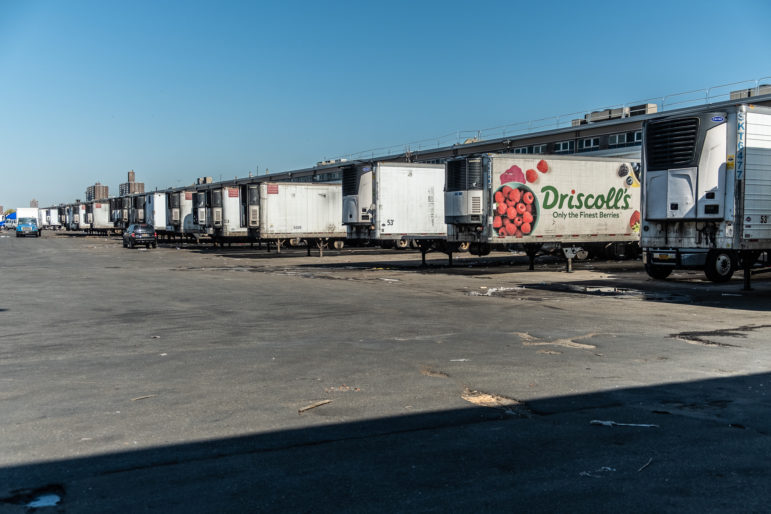
Adi Talwar
Refrigerated trailers at the Hunts Point Market.
“We are extremely excited by the progress being made on the Produce Market redevelopment project, which will eliminate all diesel-fueled TRUs from that site and winning $15 million in Federal BRIC [Building Resilient Infrastructure and Communities] grant funding to floodproof the Meat Market and Citarella/Sultana,” a NYCEDC spokesperson said in a statement.
“Additionally, through our great working relationship with our tenants at the Produce Market we have brought additional flood protection measures at the Meat Market in the form of HESCO barriers and tiger dams and needed backup generation.”
Resiliency or revitalization, power or protection?
At the same time, electrical load stations in the truck lots between the four arms of the produce market remain vulnerable to water surging from the Bronx River a few hundred yards away, though NYCEDC pointed out that the market is not located in the current 100-year floodplain.
An agency official speaking on background said protecting that equipment would take a major investment—part of the sorely needed overhaul for the produce market described in Adams’ Hunts Point Forward plan.
The ground-level power stations still run on 1960s equipment and “can be a point of concern,” said Hunts Point Produce Market General Manager Philip Grant. But much of the market’s electrical equipment is stored on the second floor, and the businesses have access to tractor trailer-sized generators in case of an outage. The market would need 12 such generators in case of a total outage, he said.
Four-foot-tall loading docks provide additional protection against storm surge, Grant said. Individual business owners and warehouse workers who spoke with City Limits said they could also move produce to higher shelves in the case of a serious storm surge, though said they did not know how they would move the food out of the market if water prevented trucks from running.
At a 2019 Council hearing, Grant said merchants paid $20 million that year to improve “the aging, crumbling facility” where they rent space. Grant said that money has gone to new lighting, repairs and preventive maintenance. NYCEDC has not yet taken steps to “harden” the facility against flooding, he said.
But the market is currently installing a 1 million square-foot reflective roof and has considered adding solar panels, Grant said. The ultimate goal is a $600 million “revitalization” project, which he likened to the phased redevelopment of LaGuardia Airport. In the meantime, he said, he hopes to shore up the building against any potential flooding.
“We have to plan for the future and we have to plan for the market we have currently,” he said. “We’re redeveloping the market for sustainability and resiliency.”
NYCEDC has downplayed the risk of flooding at the produce markets and the potential impact on the overall food system. Officials referenced a 2016 Hunts Point Feasibility Study, which identified various risks to the food hub and surrounding community, but determined that the produce market was relatively safe from storm surge.
“This study found that many of the industrial buildings are already elevated and face limited vulnerability from a coastal storm surge,” the 2016 report stated. “The recommended energy resiliency project would provide substantial resiliency benefits by providing reliable, dispatchable, sustainable, and flood resilient power to Hunts Point through a combination of energy generation, solar, and storage solutions.”
Power outages were the main threat to overall operations at the produce and fish markets, while storm surge is more likely to affect lower-lying areas where the meat market, Baldor, Citarella and Sultana are located, according to the study. None of those businesses responded to emails or calls seeking comment about resiliency measures they have pursued. Staff at Citarella and Sultana declined to talk with City Limits during a visit earlier this month. NYCEDC said the three corporations mostly deal with nonperishable goods, which limits the impact of a power outage or a flood that prevents shipments from going out.
Some members of the AWG have criticized NYCEDC’s singular focus on power generation, as well as the slow pace of progress.
Maria Torres, executive director of The Point Community Development Corporation, said the power sources are needed to sustain the Food Distribution Center, but should not come at the expense of stronger interventions to stop storm surge.
“They chose energy over flood protection,” said Torres, one of the task force members.
Even in 2017, The Point and the New York City Environmental Justice Alliance shared their concerns about the natural gas-powered microgrid, according to a letter they sent to the NYCEDC and Mayor’s Office at the time. Torres said she was disappointed with the final outcome but understood the price tag on flood barriers would make them a tough sell: early estimates put the price at more than $600 million, according to a 2014 federal funding application. Still, she does not want the proposal to be totally forgotten.

Adi Talwar
Food debris outside the market
“Flood protections are still really important,” Torres said. “We dodged a bullet and we need to continue to research viable options for flood protections.”
While cash is an issue when it comes to major flood protection projects, money so far earmarked for the more modest resiliency projects remains unspent. The city has used less than 20 percent of the $20 million grant provided by Rebuild By Design, according to a report released by Comptroller Brad Lander earlier this month
Platkin, the executive director of Hunter College’s New York City Food Policy, said the project delays and revisions, along with the unused money, highlight an overall lack of transparency around resiliency at the Hunts Point markets. The NYCEDC’s Hunts Point resiliency website does not reflect the status of the projects or the changes to the microgrid plan.
“This is such a critical component of New York City and such a critical component of our food system, so why isn’t there a more transparent approach to tracking moneys, really illustrating what the resiliency is going to be, having a website dedicated to this so everyone can know about it?” said Platkin, who convened Food Distribution Center leaders at a 2016 summit.
Community Impact
The 2016 Food Flow report found that the city’s “point-of-sale outlets”—like grocery stores and bodegas—keep an average of four to five days of food in stock, mitigating the potential risk of a problem in Hunts Point. “Because of the high fragmentation of the food distribution system,” the report stated, “the food system is unlikely to be significantly impacted by disruption to a single distributor.”
NYCEDC officials also pointed to other food distribution hubs across the city, including sites in Maspeth and Sunset Park, included in the Food Flow study—though the Hunts Point market accounts for 1 billion pounds more food than all of them combined.
Yet, as City Limits reported in 2017, a prolonged problem at the Hunts Point Food Distribution Center would specifically affect independent businesses like bodegas and small grocery stores located in underserved communities.
“Because Hunts Point supplies a disproportionate share of the food wholesaling needs of low-income neighborhoods in New York, the impacts of damage in that area would be felt most dramatically in the communities with the fewest retail food alternatives,” the 2013 Special Initiative for Rebuilding and Resiliency stated.
The Food Flow report also fails to capture another crucial role that the markets play for low-income New Yorkers: Hunts Point is the main source of produce and protein for the city’s largest food rescue operations, meal delivery programs and pantry providers.
Food Bank for New York City operates out of a 90,000-square-foot warehouse at the meat market, the central node in a network of 900 pantries, shelters, schools and social service providers that work with the organization. New York Common Pantry, City Harvest andCityMeals on Wheels each have warehouses just outside the Food Distribution Center boundary, and shop at the markets.
Nearly 1.9 million New Yorkers experience food insecurity—a key poverty indicator defined as a lack of consistent access to enough food for a healthy lifestyle—according to an analysis by the policy group Feeding America. While New York City’s broader food economy may be able to sustain a major disruption in Hunts Point, hundreds of thousands of low-income New Yorkers and seniors could suffer if the food markets shut down, said Torres, president of The Point.
“Not having enough food is still an issue and it was really glaring throughout the pandemic,” she said. “If things are flowing as freely as they are now and people still don’t have enough, just imagine if it gets clogged up. It’s definitely going to have an impact on the neediest people whether it’s this community or other communities across the city.”
But Food Bank for New York City President and CEO Leslie Gordon said her organization is prepared for any scenario.
“Food banks are made for moments like this. It’s what we do,” Gordon said. “People should consider us part of New York City’s disaster and crisis response system.”
Gordon, whose mother Myra Gordon ran the Hunts Point produce market for 35 years, said the organization could bring in equipment to pump out water, use higher pallet racks and tap subwarehouses in other parts of the city, Westchester County or New Jersey to store and deliver food.
Food Bank for New York City is part of the group Voluntary Organizations Active in Disaster (VOAD), where nonprofits coordinate their responses to emergencies like storms. That existing collaboration would also help in an emergency, Gordon said.
“Everyone needs to be able to turn on a dime in a situation like that,” she said. “We all work together in a coordinated fashion to get people the resources they need in the way they need it.”
Racine Lee Droz, the director of food sourcing at City Harvest, said her organization would also work with VOAD partners to find additional sources of food—like items approaching their sell-by date at supermarkets—that they could distribute to supportive housing sites, pantries, senior centers and other drop-off locations.
City Harvest picks up and delivers more than 2 million pounds of food from the meat and produce markets each year, and also works with major supermarkets to acquire food, Droz said.
Sandy was a “learning moment” when it came to coordination, she added. They put those lessons into practice in the early days of the pandemic.
“It’s important to establish those relationships before a disaster because if disaster hits, you’re prepared,” Droz said.
At a warehouse just outside the Food Distribution Center, workers drive forklifts to move pallets of onions and other vegetables stored and distributed by New York Common Pantry. Last fiscal year, the organization distributed 9.3 million meals, many of them to seniors.
New York Common Pantry is now in the process of moving to another 20,000-square-foot warehouse located outside the floodplain. The organization’s deputy executive director, Judith Secon, said the risk of flooding in Hunts Point was a key consideration as they sought a bigger facility. They plan to set up cold storage as well as a stand-alone pantry for Hunts Point residents to visit, she said.
Secon said she worries about sewer back-ups—a problem at New York Common Pantry’s East Harlem site—more than floodwaters from the nearby rivers. In the event of a flood, she said staff would move some food to higher racks and the rest to a section of the building at a higher elevation.
Common Pantry has also considered placing solar-powered generators on the roof in case of an outage, she said. “There is the fear of losing power,” she added. “We would be able to get food out, but we would lose some.”
‘We don’t want them going to Philly’
Back at the markets, business owners and supervisors say there is only so much a business can do if a storm surge does strike. Few companies can afford to keep spare warehouse space, said Mosner, of Mosner Family Brands.
“Commercial space is so tough to come by for primary space, let alone back up,” he said. “We have almost 700,000 square feet of refrigerated space. You don’t just pick up and move that to space waiting for you in Lodi, New Jersey.”
“That’s why the power was so important,” he added, referring to the backup generators.
A warehouse manager at one of the stand-alone corporations, who asked to remain anonymous so he does not get fired, said his company has no clear strategy in case of flooding. He said he assumes they would place the products on higher shelves. The company could withstand the financial hit, but the city would feel the impact from any disruption at the market, he said.
“Everyone depends on these markets, from big grocery stores to the little fruit stands,” he said. “Imagine not having food? That would be bad.”
The various markets have also developed some contingency plans, officials told City Limits.
Grant, the general manager at the produce market, said businesses participate in semi-annual preparedness trainings centered on communication. In a serious power outage, they could also share refrigeration space or ask for help from the meat and fish markets, he said.
Communication is indeed crucial at the produce market, where hundreds of workers maneuver forklifts and other machinery along narrow loading docks lined with pumpkins, tomatoes, pineapples, potatoes and produce from all over the world.
‘“It’s a coordinated dance,” Grant said. “If we couldn’t operate, it would be a pretty dramatic change for the city.”
Robert Urbina, a foreman for the company Rubin Bros., began working at the market as a teen tagging along with his dad. He said the experience makes him, like many of his peers, a “market baby” with a deeper perspective on the vicissitudes of the hub and overall food chain.
A flood could be a problem, he said, but he remains more concentrated on issues elsewhere in the country that ripple into The Bronx. Recent floods in Florida destroyed farms, while lengthy inspections at the Southern Border can hold up deliveries.
“Whatever happens there affects here,” he said. “Lettuce goes through the roof.”
But to Anthony Quiñones, a foreman for the company J. Margiota, any disruption at the Hunts Point market could have longer-term consequences. Eleven years ago, Philadelphia opened the world’s largest indoor, refrigerated wholesale produce terminal—a modern facility compared to the decades-old Hunts Point terminal.
“We depend on this,” said Quiñones, who has worked at the market for 32 years. “We don’t want customers going to Philly.”





